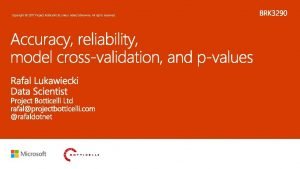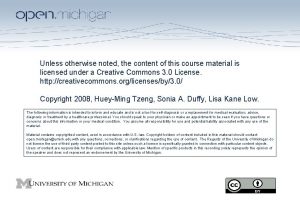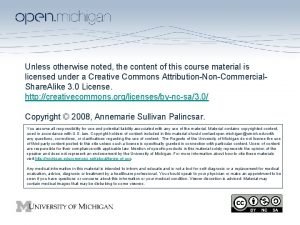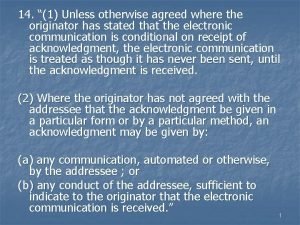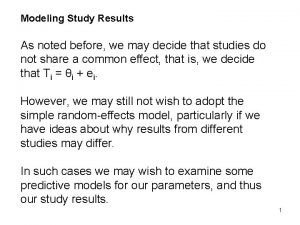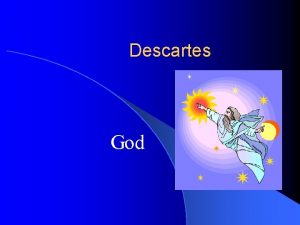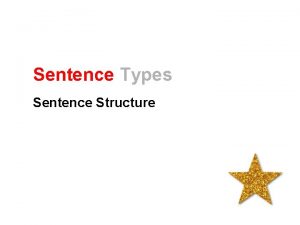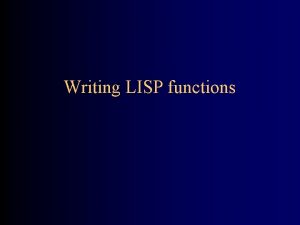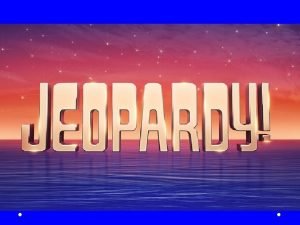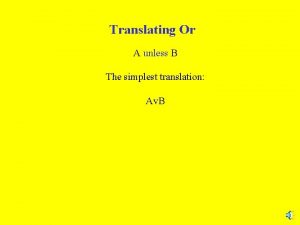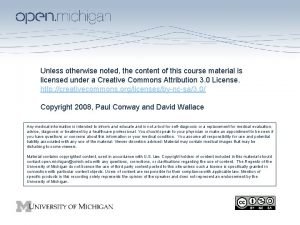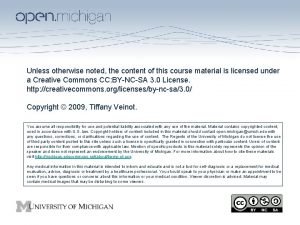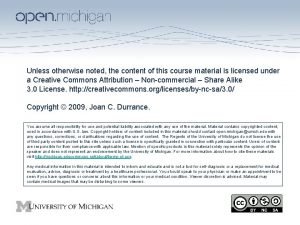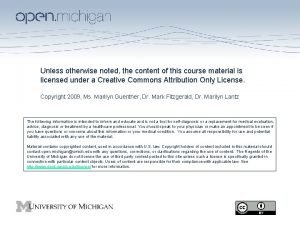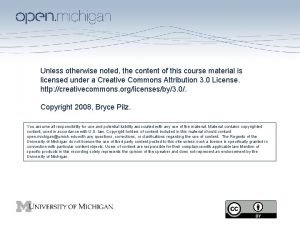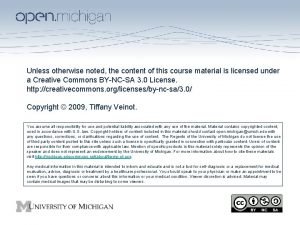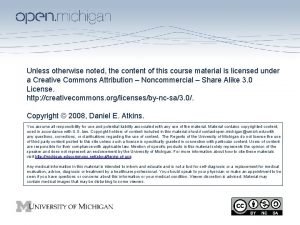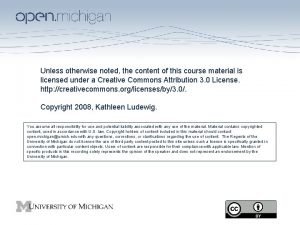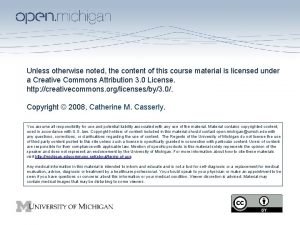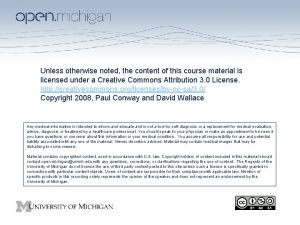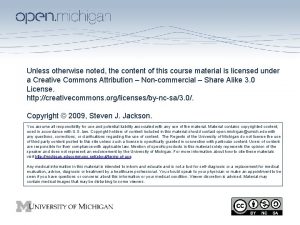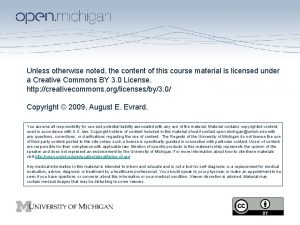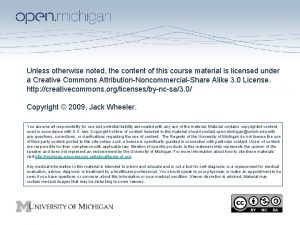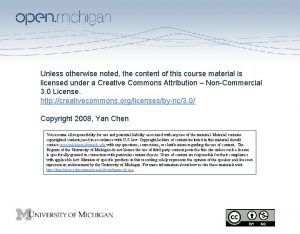Unless otherwise noted the content of this course

















- Slides: 17

Unless otherwise noted, the content of this course material is licensed under a Creative Commons Attribution – Non-commercial – Share Alike 3. 0 License. http: //creativecommons. org/licenses/by-nc-sa/3. 0/ Copyright © 2009, Joan Durrance. You assume all responsibility for use and potential liability associated with any use of the material. Material contains copyrighted content, used in accordance with U. S. law. Copyright holders of content included in this material should contact open. michigan@umich. edu with any questions, corrections, or clarifications regarding the use of content. The Regents of the University of Michigan do not license the use of third party content posted to this site unless such a license is specifically granted in connection with particular content. Users of content are responsible for their compliance with applicable law. Mention of specific products in this material solely represents the opinion of the speaker and does not represent an endorsement by the University of Michigan. For more information about how to cite these materials visit http: //michigan. educommons. net/about/terms-of-use. Any medical information in this material is intended to inform and educate and is not a tool for self-diagnosis or a replacement for medical evaluation, advice, diagnosis or treatment by a healthcare professional. You should speak to your physician or make an appointment to be seen if you have questions or concerns about this information or your medical condition. Viewer discretion is advised: Material may contain medical images that may be disturbing to some viewers.

Librarians & their Clientele: Anticipating Info Needs SI 643 February 12, 2009

Wilson, T. D. (2005). Evolution in information behavior modeling: Wilson's model, In: Theories of information behavior • • T. D. Wilson, theorist Holistic approachs since the early 1980 s Coined the term “information behavior” Develops models to show components. Image of T. D. Wilson removed Source: http: //informationr. net/tdw/

Universe of Knowledge Information System User’s Life-World Reference ‘Mediator’ EMBODIMENTS OF KNOWLEDGE USER ‘Technology’ Group Information Seeking Paths T. D. Wilson 1981

Harris, R. M. , & Dewdney, P. (1994) • Barriers to information: How formal help systems fail battered women. Westport, CN: Greenwood Press. (Ch 2: Theory and research in information seeking)

Information Seeking Insights • Information needs arise from the help-seeker’s situation • The decision to seek help (information) is complex. • Needs arise when a person recognizes a gap in the ability to make sense of something • People seek information that is most accessible - (zipf’s law principle of least effort) • People tend to seek help or information first from their own experience • In general people prefer – interpersonal sources – from people like themselves and those they TRUST

Information Seeking Insights • Info needs, seeking & use are influenced by a number of cognitive, affective, & situational dimensions. • Uncertainty may drive the need to seek information. • People follow habitual patterns (strategies, systems, etc. that worked in the past) • People seek help from sources thought to be helpful, trustworthy, reliable. • Formal sources of help (systems) may be used less frequently than people. • Information seeking models are, of necessity, complex. • More information needs, seeking, use knowledge: SI 551

JASIST ARTICLE • Fisher, K. E. , Durrance, J. C. , & Hinton, M. B. (2004). Information grounds and use of need-based services by immigrants in Queens, NY: A context-based, outcome evaluation approach. Journal of the American Society for Information Science & Technology, 55. 8, 754 -766.

IMLS STUDY & METHODS • Multi-year, multi site study to identify outcomes funded by IMLS • Study Team site visit to Queens (2002) • We conducted interviews with 15 selected QBPL, focusing on the New Americans Program & the Adult Learner Program • We observed clients and staff at NAP/ALP • QBPL Staff conducted short interviews (in clients’ language) with 30 NAP and ALP users – – – Reason using QBPL service What hope to gain What else would help How learned about the service used Families’ use of QBPL

QUEENS BOROUGH IMMIGRANT POPULATION • NYC’s highest ethnic population-1 M born (41% of Queens residents) born outside US • More than half speak a language other than English; 14% say they do not speak English well. • More than 100 languages spoken. • Some from oral tradition cultures; • Other immigrants speak and read several languages; • Some hold advanced degrees. • People have a variety of reasons/motivations for gaining English skills • Immigrant needs vary considerably.

Queens Public Library Immigrant Programs • http: //www. queenslibrary. org/ • Google Queens Library New Americans Program • Google Queens Library Adult Learner Program • Our Research Questions § How do immigrants use and benefit from NAP/ALP? § How does “context” shape these outcomes? § Do NAP and ALP fit as info grounds?

INFORMATION GROUNDS • Synergistic environment temporarily created by behavior of people who come together to perform a given task, but from which emerges a social atmosphere that fosters the spontaneous and serendipitous sharing of info (Pettigrew, 1999) • Info flow is a byproduct of social interaction • Foot clinics, playgrounds, barber shops, beauty salons, quilting bees, places of worship … • Info Grounds result from a confluence of contextual factors

QBPL NAP/ALP Contextual Factors • Contextual factor #1: The immigrants of Queens, NY (diverse by nature; needs diverse; face barriers) • Contexual factor # 2: QBPL & Its Immigrant-Focused Activities • Contextual factor #3: Professional contributions of QBPL staff

QUEENS PUBLIC LIBRARY NAP, ALP SUMMARY • QBPL Service Delivery – 63 branches + 6 adult learner centers – Immigrants served through various programs: • • New Americans Program (NAP; coping skills, cultural awareness) Adult Learner Program (ALP, English lang/literacy) Activities of these two services include: – thousands of public programs/year on multiple topics (cultural programs, etc. ); – ESOL classes at various levels; – tutoring; – conversation groups; – workshops on coping skills of various sorts), – collaboration with community organizations. – Extensive marketing using ethnic media. Users interact selectively, may use more than one component.

Outcomes Needs Giving Seeking Use Positive/Negative Uses Impacts Helps Benefits Information Ground • • • Context rich, Temporal setting Instrumental purpose Social types, Social interaction Informal & formal info flow Alternative forms of info use Sub-contexts create grand context (outcomes model)

WHAT WE FOUND: • Ranges of outcomes: building blocks + personal gains • Immigrants and their families tended to become long-term QBPL users— • Through social networks some are aware of QBPL before reaching US • NAP/ALP assist users in meeting info, psych, social, and practical needs • QPL’s programs appeared to function as an Info Ground • Challenge for libraries: to design spaces that may foster social interaction

Image of immigrant gains from library use removed Figure 1 can be found in the “Queens Borough Public Library New Americans (NAP) and Programs Case Study Report” at http: //www. si. umich. edu/~durranc e/casestudies/casestudyreports/ Queens. Report. html
 Unless noted otherwise
Unless noted otherwise Unless otherwise noted meaning
Unless otherwise noted meaning Unless otherwise noted meaning
Unless otherwise noted meaning Unless otherwise agreed
Unless otherwise agreed Nigel barker age
Nigel barker age Noted
Noted Factitious ideas examples
Factitious ideas examples Carrier content and real content in esp
Carrier content and real content in esp Dynamic content vs static content
Dynamic content vs static content Sentences that start with unless
Sentences that start with unless Sandy feels dirty unless she bathes and changes
Sandy feels dirty unless she bathes and changes Fill in the blank. you finished your homework?
Fill in the blank. you finished your homework? Unless
Unless Lisp cond
Lisp cond One sees his finish unless good government retakes the ship
One sees his finish unless good government retakes the ship Act english jeopardy
Act english jeopardy A unless b
A unless b Luke 13:3-5
Luke 13:3-5
